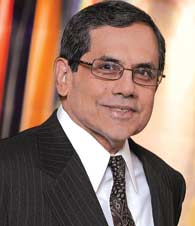|
Executive Interviews: Interview with John C Camillus on Business Model Innovation
May 2009
-
By Dr. Nagendra V Chowdary
 John C Camillus
John C Camillus Donald R. Beall Professor of Strategic Management, Joseph M. Katz Graduate School of Business and College of Business Administration. 
Mark W Johnson and his coauthors
in their recent article
(Reinventing Your Business Model,
HBR, December 2008) observed, “an
analysis of major innovations within
existing corporations in the past
decade shows that precious few have
been business-model related.” Why
do you think there are so few
business model innovations coming
from the existing companies?
Businesses that have achieved
success by employing a particular
business model are prone to fall
victim to the “winners curse.” Their
frame of thinking, their organizational
architecture and their power
structure are all tailored to their
existing model. Change and
innovation are resisted in such
situations. The threat of imminent
demise is a force that can overcome
this inertia, as is currently evidenced
by the US auto companies.
Alternatively, visionary leadership is
essential for such change to occur. Just like the way in which
venturing into a new business model
is important, is it also not important
to bid goodbye to an old business
model? What are the signals/triggers
that the companies should look at to
decide to divorce from the existing/
old business model? (Are there any
illustrative examples of companies
that have successfully abandoned
their old business model before
inventing, adapting and nurturing the
new business model?
This is the billion-dollar question.
Organizations are constantly faced
with the question of whether
continued investment in an existing
business model and strategy is
preferable to radical change and
innovation. There are occasionally
strong signals of the need for radical
change, such as continuing and
significant decline in performance,
the emergence of disruptive
technologies or newly-dominant
approaches developed by competitors. It is the “weak signals,”
as Igor Ansoff called them that are
both important and difficult to spot.
Organizations that do well at spotting
weak signals tend to engage in
continuous environmental scanning
directed at potential sources of
disruptive change, such as
technological and regulatory
developments. A willingness to experiment
continuously, dealing with ‘failures’
in a learningmode is highly desirable.
A healthy acceptance of the unpredictability
and, indeed, “unknowability”
of the future helps
organizations recognize the need for
creating rather than trying to
anticipate the future. Robust actions
identified through possibility
scenarios and Pareto analysis offer a
reassuring foundation for change in
response to weak signals and an
unpredictable future. A few existing companies come out
with a steady flow of innovations. For
instance, Virgin, Google, P&G, Apple,
etc. How to distinguish a product or
process innovation from a business
model innovation?
That is a difficult question to answer.
What is a process innovation in one
context could be viewed as a change
in the enterprise model in another.
Cumulative process and product
changes can result in changed
business models. Classifying these
changes is perhaps not as important
as making them happen. Through its “Design Thinking”
initiative and other initiatives, P&G
was able to instill a new innovation
DNA in its organizational culture.
How should companies go about
fostering an innovation culture,
wherein innovation is no longer the
prized prerogative of only the R&D
department and it can come from any
corner of the company?
Innovation can and should come
from everyone in the organization.
For instance, Solectron Centum in India requires every employee from
the CEO to the newest person on the
shopfloor to propose and document
at least one improvement every
month. It should also be recognized
that “chance favors a preparedmind.”
The perceptive and painstaking
research conducted by Gaurab
Bhardwaj, who has been interviewed
by you, revealed the importance and
basis of the insightful recognition of
serendipitous developments that
resulted in billion-dollar drugs at
DuPont. He describes the “moving,
anchored” nature of the formal search
processes that supported innovation
in DuPont’s industry models as well
as in its products. Companies such as
3M and Google readily provide
resources and time outside the formal
channels to encourage employees to
experiment. And the organizational
culture should value and reward
initiatives that do not work out, if
they have been well conceived and
executed. GE, in its newsletters has
lauded employees who have taken
calculated risks and not succeeded.
In Fujitsu, there is no such thing as a
major project that is deemed a failure.
An “unsuccessful” experiment, if
carefully analyzed can provide
valuable knowledge and learning and
motivate real-time responsiveness to
developments.
|
